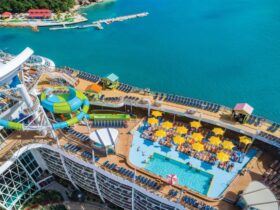From popular tourist attractions to the less-trodden paths, Japan’s Kansai region offers the best of both worlds

Accessible by a direct flight from Singapore, Osaka, Japan’s third largest city, is a familiar name to many. But beyond its modern architecture, colourful neighbourhoods and famous street snacks, Osaka is also the perfect starting point for exploring the surrounding Kansai region.
Urbanites will love Osaka’s vibrancy and zest, and there is no better place to soak in the vibe than at Universal Studios Japan (¥7,200 (S$79) for a one-day pass). The star highlight here is perhaps The Wizarding World of Harry Potter, an attraction so popular it still attracts daily long queues even after having been open for a year.
I found myself spellbound by the magic of the signature Harry Potter and the Forbidden Journey 3D ride, where I soared through a Quidditch match, dodged the Whomping Willow and screamed in the face of the Dementors. It was the ride of my life.
If theme parks aren’t your cup of tea, hop over to the Rinku Premium Outlet, Western Japan’s largest outlet mall, a 20-minute shuttle bus ride from Kansai International Airport (¥200 each way). Housing over 210 shops, you can find designer brands such as Anna Sui, Burberry and Bally, along with mid-range ones like GAP and Nike. Don’t forget to stop by the customer service counter, where tourists can get a booklet of discount coupons.
Kyoto: Osaka’s cultural counterpart

If Osaka is an epitome of a modern Japanese city, then Kyoto — a short 30-minute train ride from Osaka station via special rapid trains — must be its cultural counterpart.
Kyoto alone houses over 2,000 shrines and temples. Shinto shrines are places of worship and the locals typically visit to pay respect to the kami (Shinto gods) for good fortune or during special festivals.
You can recognise a shrine by its Torii gate at the entrance. One must also follow a ritual of cleaning hands and mouth at a water fountain before entering the shrine.
We visited the Motoise Kono Shrine, located in Amanohashidate in Miyazu city, Kyoto Prefecture, about a two-hour ride from Kyoto station.
The Motoise Kono shrine is one of only two highest-ranked shrines in the whole of Japan. This prestigious ranking is marked by the decoration of five coloured balls called suedama — in red, black, white, green and yellow — on the shrine’s balustrade.
At Amanohashidate, loosely translated as “bridge to heaven”, visit Kasamatsu Park. There, in an observatory shaped like the Chinese character for ‘one’, you can have a bird’s eye view of the area via chairlift or cable car.
At the park, visitors usually try the traditional “Matanozoki” position — with one’s back to Amanohashidate, bend down to look at the view between the legs. Amanohashidate will then look like a bridge to heaven.
Tottori: Where manga lovers unite

Tottori, a 2½-hour train ride from Osaka, may be small but many manga lovers flock to this prefecture for one reason — it is the birthplace of Gosho Aoyama, author of the best-selling Japanese manga series, Detective Conan. In central Tottori, visit the Gosho Aoyama Factory, a museum where you can find a showcase of Aoyama’s life and original works.
Tottori is also home to a wonderful masterpiece of Mother Nature – the Tottori Sand Dunes. Possibly the most famed attraction of the prefecture, the sand dunes are a beautiful natural formation made up of sand and volcanic ash, and created over a period of 100,000 years.
Spanning 16km long and 2km wide, the 50m hills of the sand dunes change shape every day. It was a tough climb up the hills, with hot sand burning my feet as I wasn’t wearing covered shoes. However, ascend to the top and you’ll be rewarded with a spectacular view of boundless sand and sea.
Visitors to the Tottori Sand Dunes should also visit the nearby Tottori Sand Museum, which features intricate sand sculptures by international artists.
Don’t forget to also visit the Tottori Nijisseiki Pear Museum, the only pear-themed museum in Japan. Located in Kurayoshi city, you’ll get to learn the history of the Nijisseiki Pear, sample pear varieties and marvel at Japan’s biggest pear tree.
Hyogo: A step back in time

A sense of tranquillity sets the stage for the onsen (hot spring) town of Kinosaki Onsen in Toyooka city of Hyogo Prefecture. Accessible by a 2½-hour train ride from Osaka, you’ll be forgiven for thinking you’ve travelled back in time.
Quaint classic Japanese architecture and willow trees line the two sides of the river at the heart of the town. Old Japanese couples clothed in yukatas (casual kimonos) stroll in their wooden geta (Japanese clogs) with great ease. Said to be one of the best onsen towns in Japan, Kinosaki exudes the tradition and culture of old Japan.
There are many ryokan (Japanese-style inns) in Kinosaki to fit any budget, ranging from basic no-frills establishments to luxurious hotel-like ones.
We stayed at Nishimuraya Hotel Shogetsutei (around ¥29,000 per person), a high-end ryokan surrounded by beautiful mountain greenery. A stay comes with breakfast and a kaiseki (traditional multi-course) dinner that features fresh local ingredients and the renowned Tajima beef — from the stock cattle of the world-famous Kobe beef.
I was swept away by the charming little town and the unsurpassed Japanese hospitality. My time at Kinosaki Onsen turned out to be the highlight of my trip.
How to get there
Singapore Airlines flies direct to Kansai International Airport. To travel between the cities, you can buy the Kansai Thru Pass at the airport or the JR-West Rail Pass online at www.westjr.co.jp/global/en/.
By Katherine Goh
ADVERTISEMENTS










Leave a Reply